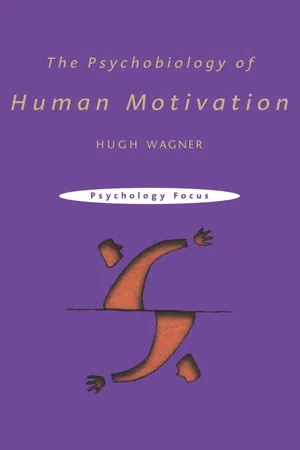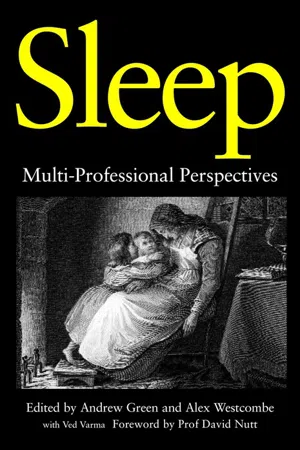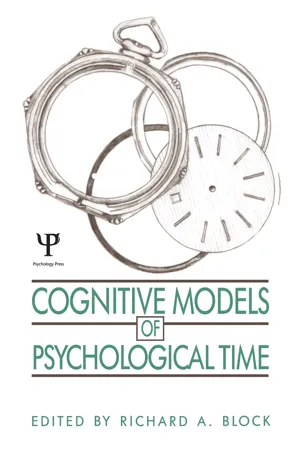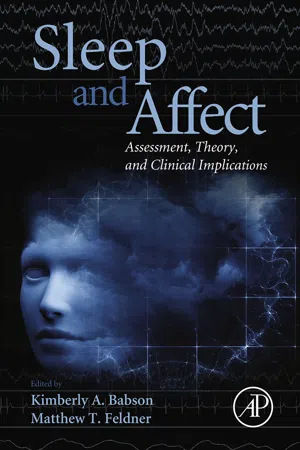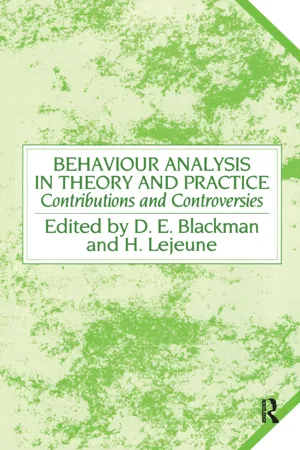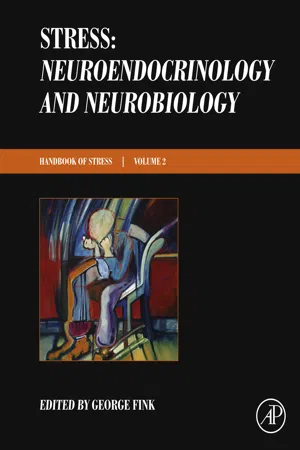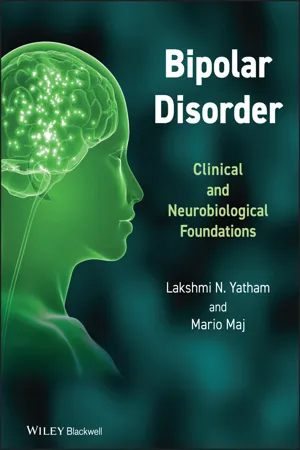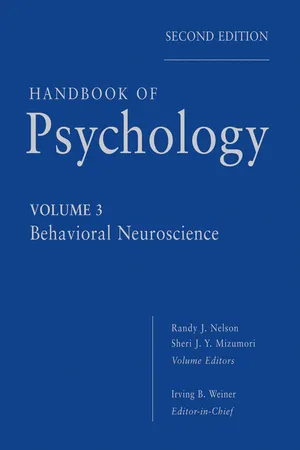Psychology
Circadian, Infradian and Ultradian Rhythms
Circadian rhythms are biological cycles that occur approximately every 24 hours, influencing sleep-wake patterns and hormone release. Infradian rhythms have a longer cycle, such as the menstrual cycle in humans. Ultradian rhythms are shorter cycles, like the stages of sleep or fluctuations in body temperature throughout the day. These rhythms play a crucial role in regulating various physiological and behavioral processes.
Written by Perlego with AI-assistance
Related key terms
8 Key excerpts on "Circadian, Infradian and Ultradian Rhythms"
- eBook - ePub
- Hugh Wagner(Author)
- 2014(Publication Date)
- Routledge(Publisher)
Chapter 3Biological rhythms and sleep■ Circadian rhythmsJet-lag and shift-work■ Other biological rhythms■ Mechanisms of biological rhythms■ The nature of sleepElectroencephalography Rapid eye-movement sleep Sleep across species Development of sleep■ Sleep deprivation■ Dreaming■ Mechanisms of sleep■ Functions of sleep■ Summary■ Further readingLIFE is DOMINATED BY a daily drive to fall asleep. Such rhyth-micity is characteristic of animal and even plant activity. While the daily cycle of sleeping and waking is the most obvious rhythm for us, there are others, as we shall see. The importance to psychology of such rhythms is that they involve variations in motivated behaviour, emotional state and cognitive performance. For psychobiology the questions are, for example, what are the origins of these cycles? Are they driven by an internal clock? How are they influenced by external events? What are their implications for daily life? What happens if they go wrong or if we disturb them? Why do we spend about one third of our lives asleep?Circadian rhythms
The daily sleep-waking rhythm is known as a circadian rhythm (meaning ‘about daily’). Humans (and most other primates) are diurnal (meaning active in daylight), while many other animals (e.g. rodents) are nocturnal. The circadian rhythm is most obvious to us as a daily alternation of sleeping and waking. But it is much more than that: underlying the sleep-waking cycle are continuous - eBook - ePub
Sleep
Multi-Professional Perspectives
- Alex Westcombe, Andrew Green(Authors)
- 2012(Publication Date)
- Jessica Kingsley Publishers(Publisher)
3
Chronobiology
BIOLOGICAL RHYTHMS THAT INFLUENCE SLEEP
Katharina Wulff3.1. Introduction
Chronobiology is the scientific study of biological rhythms in living organisms. Whereas humans have divided time into units of seconds, minutes, hours, weeks, months and years, nature follows ‘biological time’. This is determined by alternations in light/dark phases and high/low temperatures driven by the rotation of the earth around its axis. Because of the tilt of the axis as the earth orbits the sun, environmental conditions cycle in a seasonal fashion from the poles to the tropical zone at the equator.All living plants and animals have developed biological clocks that permit them to survive under these rhythmic conditions. The mechanisms that control rhythmic processes are manifested at every level of biological organization – from genes to neuronal networks and other secondary messengers, such as hormones. Evolved over millions of years, the genetic code holds a blueprint for a biological clock, which tracks the passage of approximately 24 hours. Biological or ‘circadian clocks’ (from circa = about, and diem = a day) drive physiological and behavioural processes such as blood pressure, body temperature and hormone production, as well as sleep, alertness and mood. In temperate and tropical zones, we experience a 24-hour pattern in light/dark exposure, which our circadian clock uses to adjust its internal clock work, thereby aligning internal biological time to the environmental day/night cycle. The clock’s output signals are used to anticipate predictable environmental changes and to adapt physiology for forthcoming behavioural changes.This chapter describes how organisms use internal circadian timekeeping to adapt to a periodic environment by using physiological processes that track time and help anticipate predictable local changes, such as the quality of light. First, it describes the principles of measuring biological time and how biological clocks work. Then it illustrates how these clocks regulate human sleep/wake timing and how our sleep/wake cycle responds to disruptions of internal clocks. In the last part of the chapter, attempts are made to explore medical implications of unrecognized circadian problems and their effects on sleep, mental health and well-being. - eBook - ePub
- Richard A. Block(Author)
- 2014(Publication Date)
- Psychology Press(Publisher)
As the evidence presented later in the chapter indicates, it is quite likely that the process by which humans estimate the passage of long time intervals is intimately related to the endogenous circadian system assumed to be responsible for the temporal regulation of numerous functions of the body and brain. Therefore, it seems useful to begin with a brief overview of this biological timing system.The Nature of Circadian Rhythms
Discovery of Circadian Principles
In response to the natural alternation in light and darkness, virtually all species have developed endogenously mediated rhythms with frequencies close to 24 hr. The pervasive nature of such rhythmic components in physiology and behavior suggests that this circadian (circa = about, dies = day; Halberg, 1959) temporal organization is vital to the overall wellbeing of the organism. Among the numerous systems and functions mediated by the circadian timing system are hormonal output, body core temperature, rest and activity, sleep and wakefulness, and motor and cognitive performance. In all, literally hundreds of circadian rhythms in mammalian species have been identified (see, for example, Aschoff, 1981; Conroy & Mills, 1970), and Aschoff (1965) has noted that "there is apparently no organ and no function in the body which does not exhibit a similar daily rhythmicity" (p. 1427).The proof that such rhythms are governed by factors inherent to the organism, rather than by the environmental cues with which they are typically synchronized, can be derived only from studies of organisms living in the absence of external factors that may provide cues to time of day or, more generally, to the passage of time. The first published study to utilize such a methodology reported on the daily leaf movements in a plant, Mimosa pudica - eBook - ePub
Sleep and Affect
Assessment, Theory, and Clinical Implications
- Kimberly Babson, Matthew Feldner, Kimberly Babson, Matthew Feldner(Authors)
- 2015(Publication Date)
- Academic Press(Publisher)
When a rhythm of a biological process cycles during such a time it is referred to as a circadian rhythm (“circa” is Latin for about a day). Even though the sleep-wake cycle is often used as an example of such a rhythm, it was not considered important to the early sleep researchers (Dement & Vaughan, 1999). This was due to fact that early sleep scientists often used cats as a model for sleep. Studying an animal that can sleep anytime anywhere had its advantages of course. But cats are one of the few animals that have poor circadian oscillation and can sleep at any time, as any cat owner can attest. However, as scientists turned more to studying other animals (including humans), it became evident that there are other processes and brain circuitry that can make sleep easier to obtain at certain times of the day, and, conversely, when wakefulness is easier to maintain. There is a time for many words, and there is also a time for sleep. Homer Circadian Rhythms Although there are times during the day that we feel wide awake and others when we feel tired, most of us do not simply fall asleep randomly, without warning. Humans generally wake and sleep on a fairly predictable daily schedule. How does our body know when to sleep? While many contributing and complicating factors come into play, the underlying drives can be thought of in a simplified, two-process model first proposed in 1982 by Dr. Alexander Borbély, a Swiss sleep researcher (Borbély, 1982). This model suggests that our propensity to sleep can be thought of as the interaction between two different processes: the length of time awake (Process S; Figure 1.4) and our intrinsic circadian rhythm (Process C). Process S is the more straightforward of the two: an exponential increase in sleep propensity (as derived from slow wave activity) the longer one is awake. Conversely, that propensity declines in an exponential fashion with sleep - eBook - ePub
Behaviour Analysis in Theory and Practice
Contributions and Controversies
- Derek E. Blackman, Helga Lejeune(Authors)
- 2013(Publication Date)
- Routledge(Publisher)
acquired timing activities are the result of learning, in contrast to the temporal regulations analysed in the first two sections, which are either an emergent property of a genetically determined system (biological rhythms) or pre-established activities with endogenous time bases (cyclic and rhythmical behaviours), even if environmental factors may play some role in their development or evolution.This descriptive review lays the groundwork for approaching a number of unresolved issues whose importance has been stressed over the last 20 years (Pouthas et al., 1986; Richelle, 1968; Richelle & Lejeune, 1979; Richelle, Lejeune, Perikel, & Fery, 1985); namely, is there a relationship or even a continuity between biological rhythms and learned adjustments to time? Are the early forms of temporal regulations the foundation for the development of the complex timing activities involving symbolic and cognitive processes found in adults?Ontogeny of Sleep and Wakefulness Rhythms in Infancy Ultradian and Circadian Oscillators of Foetal MotilityThere is considerable evidence that ultradian periodicities of motility emerge during the last third of foetal life: A regular alternation of active and quiet phases has been observed in the foetus (Junge, 1979; Timor Tritsch et al., 1978). The mean durations of these motility cycles, although variable, increase with age, from 12 min at 27 weeks to 60 min at birth (Dierker, Pillay, Sorokin, & Rosen, 1982). Some authors have suggested that the high motility phase may reflect a primitive form of active sleep (AS): (Sterman, 1967; Sterman & Hoppenbrowers, 1971). The presence of motility cycles during foetal life, as well as in premature infants (Karch et al., 1982; Parmelee, Bruck, & Bruck, 1962), together with data showing active sleep cycles in newborns (Prechtl, 1974) (although randomly organised during the first weeks of life), suggest that there is a continuity in the mechanism controlling this cyclicity from foetal life to the neonatal period (Harper et al., 1981). - eBook - ePub
Stress: Neuroendocrinology and Neurobiology
Handbook of Stress Series, Volume 2
- George Fink, George Fink(Authors)
- 2016(Publication Date)
- Academic Press(Publisher)
Part III Diurnal, Seasonal, and Ultradian SystemsOutlineChapter 40. Circadian Rhythm Effects on Cardiovascular and Other Stress-Related Events Chapter 41. Seasonal Variation in Stress Responses Chapter 42. Seasonal Rhythms Chapter 43. Ultradian RhythmsPassage contains an image
Chapter 40Circadian Rhythm Effects on Cardiovascular and Other Stress-Related Events
R. Manfredini1 , B. Boari1 , R. Tiseo1 , R. Salmi2 , and F. Manfredini11 University of Ferrara, Ferrara, Italy2 General Hospital of Ferrara, Ferrara, ItalyAbstract
Circadian rhythmicity is ensured by the circadian timing system based on input signals (environmental cues), an intrinsic rhythm generator and output rhythms. This system prepares organisms for changes in their physical environments, and to respond to environmental factors in a temporally appropriate matter. The hypothalamic-pituitary-adrenal (HPA) axis; the autonomic sympathetic nervous system; and the cardiovascular, metabolic, and immune systems contributing to maintain biological homeostasis during environmental or physiological challenges are characterized by the presence of a daily rhythm or by significant daytime variations. In combination to the individual differences in terms of diurnal preferences (chronotype), conditions evoking desynchronization of human circadian rhythms (shift–work, jet–lag exposure) or different stressors may induce significant changes in sympathetic–parasympathetic balance and tone of HPA axis. This condition in humans might negatively affect the cardiovascular system both chronically (by accelerating atherosclerosis) and acutely, via multiple mechanisms, triggering the onset of acute life-threatening events particularly in the morning. - eBook - ePub
Bipolar Disorder
Clinical and Neurobiological Foundations
- Lakshmi N. Yatham, Mario Maj(Authors)
- 2011(Publication Date)
- Wiley(Publisher)
The aim of this review chapter is to encourage further research into these important pathways, by tracing the limits of scientific knowledge about biological rhythms in BD. We first outline the basics of circadian rhythms and sleep, highlighting the challenge of empirically separating these two factors. Subsequently, literature on circadian- and sleep-moderation of emotion is reviewed, largely focusing on non-clinical populations. Evidence for an association between biological rhythms and BD is detailed next, and causal inferences considered. The following section considers potential mechanisms of biological rhythm action in BD, particularly the impact of clock genes. Finally, we introduce clinical implications of the fact that biological rhythmicity is modified by behaviour (Section 20.6).Circadian rhythms and sleep Circadian systemThe endogenous circadian time-keeping system, strongly conserved across species, is adapted to optimize engagement with the earth’s cyclic environment by predicting critical environmental change [6]. In mammals, the circadian pacemaker responsible for the temporal internal organization and generation of endogenous rhythms of approximately 24 h is located in the hypothalamic suprachiasmatic nucleus (SCN, [7]).2 At the molecular level, intrinsically rhythmic cells of the SCN generate self-sustained rhythmicity via an auto-regulatory transcription-translation feedback loop regulating expression of the Period (Per1, Per2, Per3) , cryptochrome(Cry1 , Cry2 ), TIM, DEC1 and DEC2 genes [8].3The endogenous period generated in the SCN is close to, but generally not equal to 24-hour. The process by which the pacemaker is both set to a 24-hour period and kept in appropriate phase with seasonally shifting astronomical day length is called entrainment. An important property of the circadian system, therefore, is its fundamentally open nature, and this open nature includes feedback to the pacemaker from clock-controlled activity of the organism [10]. Entrainment occurs via zeitgebers (environmental events that can affect phase and period of the clock), the most prominent of which is the daily alteration of light and dark due to the planet’s rotation [11]. To a lesser degree, the SCN is also responsive to non-photic - eBook - ePub
- Irving B. Weiner, Randy J. Nelson, Sheri Mizumori(Authors)
- 2012(Publication Date)
- Wiley(Publisher)
The mammalian circadian system undergoes significant change across the lifespan, particularly during early developmental and in later life. The developmental progression of the circadian system includes changes in the endogenous clock responsible for generating intrinsic rhythms, the development of the input pathways responsible for environmental entrainment, as well as output pathways for synchronizing the various oscillators in neuronal and peripheral tissues. The expression of behavioral and physiological circadian rhythms coincides with the completion of neurogenesis in the SCN, its innervation by the retinohypothalamic tract, and the maturation of effector systems. The timing of this process differs significantly in precocial and altricial animals, and thus overt rhythms develop at different developmental stages. Nevertheless, in general, circadian rhythms in most mammalian species are evident prenatally, entrain to the solar day within the first weeks or months of life, and may continue to change across development, particularly during adolescence and old age. In humans, the SCN are formed by the 18th week of gestation, and melatonin receptors are present, suggesting the SCN may be capable of generating self-sustained oscillations. Circadian rhythms of several physiological functions are evident during the prenatal period in altricial species such as humans, rhesus monkeys, and sheep. Human fetuses display circadian patterns in rest-activity, movement, breathing, heart rate, and urine production rhythms (Ruger & Scheer, 2009). In addition, in nonhuman primates and sheep, circadian rhythms of plasma prolactin, cortisol and vasopressin in cerebrospinal fluid are evident in the fetus (Seron-Ferre, Valenzuela, & Torres-Farfan, 2007). In preterm infants, body temperature rhythms are evident in the first days of life, even though these infants are housed under constant environmental conditions. These prenatally observed rhythms are not likely due to the entrainment effects of the mother, since several studies have noted phase differences between mother and fetus.
Learn about this page
Index pages curate the most relevant extracts from our library of academic textbooks. They’ve been created using an in-house natural language model (NLM), each adding context and meaning to key research topics.
